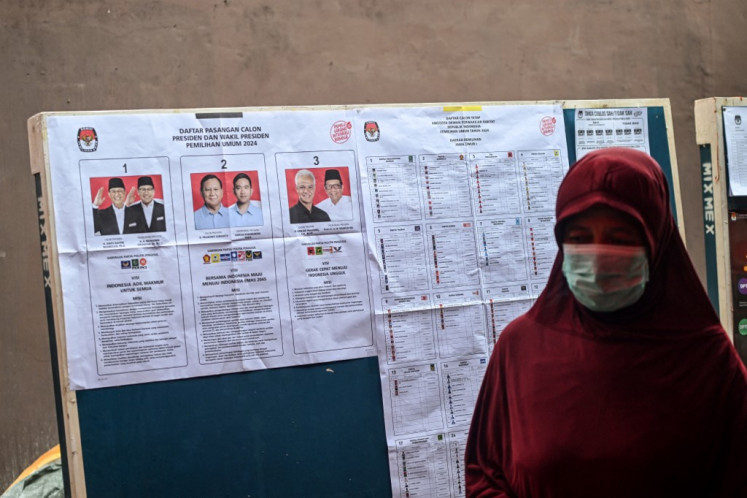Popular Reads
Top Results
Can't find what you're looking for?
View all search resultsPopular Reads
Top Results
Can't find what you're looking for?
View all search resultsSustainable green cities
The face of cities in Indonesia this year will not change much
Change text size
Gift Premium Articles
to Anyone
T
he face of cities in Indonesia this year will not change much. They will continue to experience a very rapid process of urbanization. The population residing in urban areas is estimated to increase from 54 percent in 2010 to 68 percent in 2025.
Cities that were expected to create wealth as engines of growth have actually given birth to new pockets of poverty. Indonesia’s relatively high level of poverty has led to the nation’s relatively poor ranking on the Human Development Index, coming in at 111 of 181 countries - far below neighboring countries such as Singapore (23rd), Malaysia (66th) and Thailand (87th).
Urban slums in Indonesia increased from 54,000 hectares in 2004 to 57,800 hectares in 2009. Infrastructure services are still limited in scope and quality. A large number of households had inadequate access to clean water (21.1 percent, according to the index) or did not have access to latrines (22.86 percent).
Less than half of the population (47.71 percent) had access to safe drinking water and just over half (51.02 percent) had access to decent sanitation.
According to the Millennium Development Goals, 68.8 percent of the people must have access to safe drinking water and 62.4 percent must have access to decent sanitation by 2015.
According to the Vancouver Declaration (1976), the government is responsible for providing decent housing to residents who cannot afford it. To that end, the government has vowed to clear slums in 350 cities by 2015.
A slum is characterized by buildings that are very narrow and do not meet health standards. Their conditions are so squashed that they are fire prone and lack clean water; electricity; drainage; roads; and bathing, washing and toilet facilities.
Green space has declined from about 35 percent to less than 10 percent from 1970-2010 in big cities, as a result of the construction of commercial buildings.
Ideally a city needs to allocate 20 percent of its area for public green space and 10 percent for private green space. Indonesia’s cities fall far short of those numbers.
Makassar’s green space amounts to 10 percent of the city; Jakarta has 9.79 percent; Surabaya, 9 percent; Bandung, 8.76 percent, Medan, 8 percent; and Palembang, 5 percent.
No wonder our cities are frequently hit by disasters throughout the year such as floods and road inundations in the rainy season, outbreaks of diarrhea and dengue fever in the transitional season and clean water crises, air pollution and fires in the dry season. All this is exacerbated by seawater intrusion and land subsidence in coastal cities, as well as landslides and erosion in mountainous areas.
Cities should be encouraged to become sustainable, green cities. Spatial plans must be friendly and environmentally sensitive and accommodate an adequate proportion of urban green space. Urban infrastructure development must be directed into green urban infrastructure.
Various laws support green city development including the Building Law, the Water Resources Law, the Solid Waste Management Law, the Disaster Management Law and the Environment Protection and Management Law.
There are eight things to consider when making a sustainable green city: urbanization and population, the risk of disasters and climate change, the role of the private sector and local economy, local cultural identity and heritage areas, green open spaces, area management of river basins, urban transportation and housing and settlements.
Those factors involve economic, ecological and social considerations which in practice are related to leadership and institutional urban systems. A sustainable green city should support good governance, actively involve communities in decision making that affects their lives and promote anticorruption.
Any city planning that fails to take those considerations into account will not bear much fruit.
The government and universities, professional associations and NGOs must establish an independent body to draft guidelines for sustainable urban development, validate city and district ratings and determine the appropriate forms of assistance.
Only 22 out of 33 provinces in the nation are in the process of establishing spatial planning (RTRW), with 13 having approved plans. Of 524 cities and regencies, only 260 are serious about drafting RTRW. Obviously, preparations for spatial planning should be in line with efforts to achieve a sustainable green city. They need immediate assistance.
In the future, the development of sustainable green cities should encourage a paradigm shift that leads to visionary, creative and inclusive management.
Cooperation among urban stakeholders in creating a green city, either individually or in groups, is mandatory. Revitalizing waterfront areas, developing integrated urban transport systems to support the accessibility and mobility of citizens, provision of housing and settlements which are livable, affordable, and environmentally friendly are needed.
To realize a sustainable green city, we need concrete actions, not just discourse.
The writer is chairman of the Indonesia Landscape Architecture Study Group in Jakarta.










